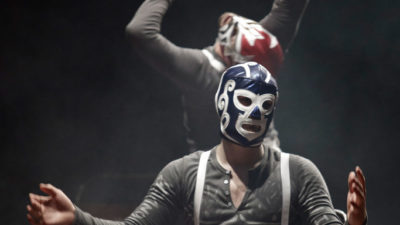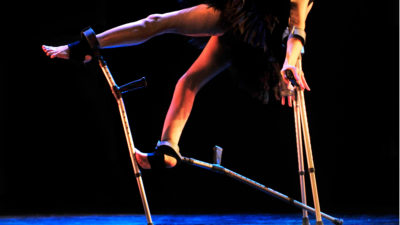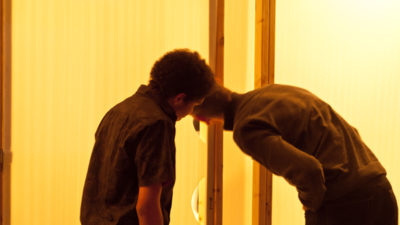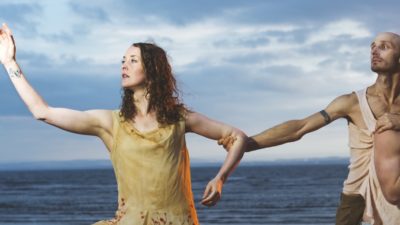There are four interviews intercut with footage of rehearsals and performance:
- Janice Parker works with disabled dancers in Barcelona
- Claire Cunningham talks to camera in a rehearsal studio
- Claire performs in Give Me a Reason to Live
- Dan Daw speaks to Emma Gladstone in the Wales Millennium Centre
- Dan performs in Beast
- Honne Dohrmann in conversation is intercut with scenes from Beheld by Alexander Whitley and Candoco Dance Company.
British Council – Leadership in Disabled Dance Full Audio Description Text
This short film lasts about eight minutes. It consists of spoken reflections by Emma Gladstone, Artistic Director of Dance Umbrella, London’s international dance festival, interspersed with interviews with dance artists and scenes from performances by companies that include disabled dancers, or created by disabled choreographers. This audio description of the film includes the spoken words along with descriptions of the performances. It will take about 15 minutes to listen to if read aloud.
The film begins with a rapid montage of scenes from seven different performances. First, a rehearsal of a scene from Yama by Damien Jalet for Scottish Dance Theatre. Seven dancers rise and fall on a raised octagonal platform with sloping edges. Long fringes on their grey costumes swirl as they turn. Miniatures by Lea Anderson features dancer Annie Hanauer of Candoco Dance Company, with a shock of frizzy red hair and wearing a sculptural costume with emerald green sleeves and giant blue collar. A video close up of her head and shoulders is projected on the wall behind like a large portrait.
Alexandrina Hemsley and Jamila Johnson-Small of Project O perform their piece O in a studio space among potted palms. They wear black leotards and long stockings, and face us to pose, flicking back long hair. The dancer in a scene from Jo Fong’s An Invitation wears an everyday top, kneelength skirt and ankle boots. She folds from the waist and arches back, one palm raised as if in greeting. The two male dancers in Igor and Moreno’s Idiot-Syncrasy are dressed identically in navy shorts and grey t-shirts. They move in unison, bouncing on the spot as they rotate.
In Beheld by Alexander Whitley and Candoco Dance Company two dancers sweep a third across the stage in a wheelchair, using a length of stretchy fabric to propel and restrain the chair. All three wear yellow tunics with vertical bands of black and red. Feathers fly as dancers pillow fight in The Impending Storm by UK-based dancers David Toole and Lucy Hind working with Remix Dance Company, South Africa’s only integrated dance company.
Emma Gladstone speaks in voiceover and then appears in a brightly lit dance studio. She’s a woman in her forties, dressed in stylish grey and black. Emma says: ‘As an art form, contemporary dance has a reputation for being inventive and questioning the status quo, work that challenges what a performance can be, what it can look like and how a dancer’s body can move. In recent years, dance that includes disabled dancers or is created by disabled choreographers has become an important part of this conversation. I want to take a closer look at how disabled dance artists are making their mark. So, who are the disabled choreographers shaking up the contemporary dance world, who are the next generation coming through and what does the wider dance sector think of their work? Janice Parker is an award-winning Scottish choreographer who has been leading a unique mentoring project in Barcelona, with the British Council, aimed at supporting local disabled dancers to consider taking up choreography.’
The film shows a group of dancers in a loose circle in a rehearsal studio, engaged in conversation: Janice sits on the floor cross-legged, three women sit in wheelchairs, another sits on the floor surrounded by sheets of paper with handwritten notes, her legs flexed wide. She has a prosthetic foot, the ankle to the knee made of plastic subtly patterned in blue and white. Janice speaks to the group, indicating the progress of a sequence with her hands. Another woman uses sign language to contribute to the discussion. A man in red t-shirt listens intently. He has no lower limbs and leans forward on muscular arms.
Janice works with a female dancer who is a wheelchair user, demonstrating a movement with arms floating upwards. The seated dancer repeats the gesture. Another dancer spins herself in a wheelchair, sweeping long black hair across her mouth like a veil. She reaches out to the horizon – and drops down over the arm of her chair.
Janice Parker says: ‘We have to ask the question, “Who can dance and what can dance be?” We have a sense of a hierarchy of a normative form at the top, which has two arms and two legs! And it’s very dominant at the moment, in our culture. How can we turn that round, not to put something at the bottom of the hierarchy, but to make a spectrum? There’s all different vocabularies in there and dance needs them all. Disabled people have that capacity to create extraordinary movement that has a whole other spectrum and vocabulary in there.’
In the Barcelona workshop, a woman who uses a motorized wheelchair and the man without legs dance together: he grips the chair’s frame as she swivels across the room, drawing him across the floor in curving loops.
Emma Gladstone continues: ‘The extraordinary movement that Janice describes is very much evident in the work of Scottish choreographer and dancer, Claire Cunningham. Claire’s work incorporates the crutches she uses in her everyday life.’
In footage of her solo show Give Me a Reason to Live, Claire is picked out by a white spotlight. She has short white-blond hair and wears a simple white vest and pants. She leans her back against a wall, her head thrown back, and balances high on two crutches, both feet clinging to one crutch as if climbing it.
The film shifts to show Claire sitting in a rehearsal studio, wearing a checked shirt, a piano in the background. She says: ‘I am more interested in movement that comes very much from an individual. I find I get increasingly bored by watching work where everybody’s trying to look the same. There is a tendency to be trying to make work for this ideal non-disabled body. I find myself far more interested in watching bodies that have a difference and have an individuality to them, and aren’t trying to impersonate the choreographer’s body or an “ideal body” that they think they should have.’
The film shows Claire in performance, raising herself into the air on her crutches, then leaning into a corner of the room, facing away from us, her arms winging backwards from the elbow.
She continues in voiceover: ‘For me, there are always questions around what that lived experience is, of the fact that we might spend more of our time being observed generally, anyway, and “performing”, in a way, publicly. Whether we mean to or not, we’re being observed a lot of the time because people look at you because you’re different and you move differently. And whether that is something that comes on stage with us.’
Emma Gladstone continues: ‘Whilst there are companies and works that feature disabled dancers, new works made by disabled choreographers are less common. Even rarer are examples of disabled choreographers being invited to share their artistic vision and create on non-disabled dancers.’
The film shows a scene from Traces Imprinted by Marc Brew for Ballet Cymru. A male and female dancer roll together. They come to stand face to face and he lifts her under the arms to swing her round. The scene changes to the exterior of the Wales Millennium Centre, Cardiff, with its copper-coloured steel façade punched through with lines by the Welsh poet Gwyneth Lewis.
Emma says: I’ve come along to British Dance Edition, a biennial presentation of British dance, international promoters and producers, to catch up with the UK-based Australian artist, Dan Daw, who has recently begun choreographing after many years as a dancer. I started by asking him why he’d made this transition.’
Emma and Dan talk in the busy theatre foyer. Dan is tall with a close-cropped sandy hair and a moustache. He says: ‘I wanted to find a way I could have more of an artistic voice.’
Dan appears in his solo performance Beast. The scene is monochromatic; his naked body is brightly lit in white, the rest the space in shadow. Metal bars and plates obscure his eyes and lower torso. He rests his fingers on his ribs as his chest rises and falls. He uses his right hand to lift his left arm across his body. The film cuts to another scene. Dan bends double over a tray which holds six mugs, a teapot, milk jug and plate of biscuits. He lifts the tray to stand upright, holding it steady as he looks out at us.
Dan explains, ‘As a company dancer, I did have a say, artistically, up to a point and I did feel I was very much a contributor. Whereas, when I’m curating work myself, I’m really involved in the process of how it’s going to happen, when it’s going to happen, why it’s going to happen. I’m still learning about how receptive and responsive audiences are to disabled makers. Essentially, because I advocate for it being about the work, I’m really interested in presenting my work in places that don’t necessarily have a disability focus. For me, it’s about the recognition by the dance industry that there is a cultural shift and to really embrace that and to not be scared of it.’
In another scene from Beast, Dan sits on the floor, wearing a white silk embroidered shift dress and opaque black tights. His legs are straight out in front of him: they tense and tremble, lifting off the floor; his back rounds as he rocks between sitting upright and rolling down to the floor. He reaches forward with alternate hands.
Back in the Wales Millennium Centre, Emma is shown chatting to a tall man with a bald head and attentive expression. She says: ‘The desire for a cultural shift and greater integration of work authored by disabled artists is a sentiment echoed by Honne Dohrmann, Director of the influential Tanzmainz, the contemporary dance ensemble of the Staatstheater Mainz.’
Honne says, ‘I hope very much for the artists and for the European sector that we, in a positive sense, “get used to it”. That they are not treated as artists in a niche. Maybe as artists who need special conditions – but as artists like others. Do they have to say something? Is it unique? How is it about the quality of the work, the development of the work through the years? They should be normally compared with other works and we, as presenters, have to find out what is their specific strength and present them in a good frame.’
Scenes from Candoco’s Beheld play as Honne speaks. A man and woman duet, the woman using crutches that become another pair of limbs in the dance. Two men duet: one rocks back in his wheelchair until it is flat on the floor; the second dancer stands, balancing himself on the frame. A third man joins them and tips the wheelchair up to vertical. Two of the dancers sink to the ground, kicking legs high behind, as the third wheels round behind them.
Emma asks Honne: ‘It seems like everyone has a role to play – the artists, the programmers and the audience. How do we take these efforts to the next level? How does the sector encourage and support the next generation of disabled choreographers?’
Honne replies: ‘In order to nurture and support disabled artists, I think the most important thing is to regularly present them, to get the critics used to seeing the work of disabled artists in order that they get a fair and concrete critique, which is constructive in helping. This is missing sometimes, I think. The last one is to make promoters, presenters, artistic directors aware of what are the possibilities for collaboration with disabled artists as dramaturges, as choreographers for non-disabled dancers.’
Honne’s final words are juxtaposed with another scene from Beheld. A woman twists against a black surface – it’s unclear if she’s crawling over a floor or standing against a wall. As the camera pans out, we realize that she stands with her back against a huge sheet of shiny black plastic, twice her height. She reaches above her head to grip the surface in her hands – it shimmers, ripples, and drops down onto her like black liquid.
Emma concludes: ‘Dance is all the richer for the contribution of disabled choreographers, but for the art form to remain bold and relevant, I believe we all need to remain open to the important questions raised by these artistic pioneers.
The final credits show a link to www.disabilityartsinternational.org and the words:
A British Council initiative, produced by Cultureshock Media.
Ends.






